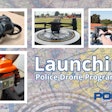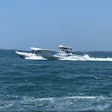Several months ago a tabletop exercise was held in Baltimore. Participating were command officers from the Baltimore Police Department, the Baltimore PD SWAT Team, the Maryland State Police, and the Maryland Port Authority. Watching from the gallery were officers from a number of other agencies.
The scenario being gamed went something like this: In international waters, terrorists intercept a container ship loaded with volatile chemicals. The terrorists kill the crew, wire the vessel with explosives, and resume the voyage into Baltimore harbor. Per standard operating procedure, as the ship enters the mouth of the harbor, a Maryland state pilot boards to bring it into dock. The pilot is sharp, he notices that things are not quite right and alerts the authorities. That leaves the players with the objective of the game. They must stop the hijacked ship from entering Baltimore's inner harbor where the terrorists can detonate their deadly cargo under the Francis Scott Key Bridge.
If the exercise had been a movie, it would have been easy. The dashing young heroes of a secret military unit, special FBI section, black ops counter-terrorist squad, or tactical police team would swing to the rescue and the terrorist plot would be foiled. But the tabletop exercise wasn't a movie; the players couldn't devise a fictional unit of invulnerable heroes to handle the problem. And since it was designed to play out in real time, the game was relentless; with each passing minute, the 300-foot cargo vessel/bomb sliced through the water on its way to the inner harbor.
The players realized that they were not equipped or trained for maritime tactical operations, so they wisely sought out some help from the experts. At their request, a Navy representative called down to Virginia Beach to request a SEAL team. He was told that "all assets were otherwise deployed." Another call went out to the 200-agent strong FBI Hostage Rescue Team (HRT). It was in Salt Lake City for the Winter Olympics.
There were no more calls to make. And the ship/bomb moved on toward the bridge.
Then an officer involved in the scenario remembered that one of the observers, Lt. Tim Cameron of the St. Mary's County Sheriff's Department, was the commander of a SWAT team that had trained for waterborne operations. Cameron was asked to join the exercise. Unfortunately, he had no magic solution to the problem. Even if his team had been standing by and ready to go, it would have taken them at least an hour to fly to Baltimore and prepare to board the hijacked container ship.
The lesson of the Baltimore exercise is quite clear: In 2002 police agencies can't just arbitrarily decide that their jurisdictions end at the water's edge and assume that anything on the water will be handled by the Coast Guard, the Navy, or somebody else.
According to Steven C. Bronson, founder and owner of Virginia Beach-based Tactical Watreborne Operations, they never could. For more than three years now, the retired Navy chief has been telling and showing police agencies that there's a serious hole in their training. Some have listened. Many have not. But after 9-11 they're considerably more receptive to the idea.
Fast Attack
"More than 70 percent of the American economy comes through ports," Bronson says. "So the water environment is definitely an area in which police need a considerable amount of training. Our law enforcement officers and especially our SWAT officers now have to have capabilities that they didn't possess a few years ago."
The idea to combine his Navy experience and his long-time interest in law enforcement into a waterborne training program for SWAT officers came to Bronson when he was watching TV coverage of the Andrew Cunanan incident. Cunanan, who was suspected of killing fashion tycoon Gianni Versace as part of a nationwide murder spree, was holed up in a houseboat in Miami when Miami/Dade Police took action live on the cable news. "I sat there and watched as the SWAT team made an approach down a finger pier, and I started looking at their movements from a safety perspective," recalls Bronson. "I realized that, for example, if the number three man in the stack had tripped over a cleat and fallen into the water, the team would have had a big problem."
Bronson explains that all of the weight the tactical officer carries on an operation is going to present great challenges if he takes an unexpected dip in a pool, lake, river, or bay. "So then you have an individual possibly drowning and the rest of the team faced with the decision do we help our teammate or make the assault." Such indecision could be deadly for the entire team. "If it was an armed, barricaded suspect, then you would have guys standing around in the open being shot at."
Drawing on his years of Navy experience manning fast attack craft and later designing and teaching fast attack craft courses, Bronson developed a waterborne tactical and survival course for police officers. And he set out to market the idea to police forces.
At first the concept was met with great skepticism. So Bronson arranged a demonstration of the waterborne capabilities a landlubber SWAT team could acquire in just a few hours of intensive training in his program.
That demonstration in the summer of '98 is still remembered vividly by the SWAT commanders who were in attendance. Bronson invited officers from 14 jurisdictions in three states to join him on the Annabelle Lee, a 300-foot sternwheeler excursion ship that plies the James River in Richmond. A training scenario was established: One of the couples on board for the dinner cruise had gotten into a fight, and the man had produced a pistol and was threatening to kill his girlfriend.
Normally, the police would have had to wait until the vessel docked to handle the situation, but not that day. With a deck full of cops watching, Bronson's team managed to board the moving vessel without being seen, move quickly into position, and subdue the gunman. "We made the takedown and had him removed before the SWAT cops who were watching were even aware that we were there," says Bronson. Officers who were aboard the Annabelle Lee during the exercise confirm that that's exactly what happened.
Bronson had sold the toughest of audiences on the value of waterborne training for SWAT officers. And one officer, Sgt. Mike Cameron of the St. Mary's County Sheriff's Department, invited him to come conduct a training program.
The Three Cs
The three-day course that Bronson's Tactical Watreborne Operations (TWO) offers to SWAT officers has one overriding mission, to give the students "comfort, confidence, and competence" in a marine environment. A good example of the content of the program is the recent class that TWO offered before TREXPO West in Long Beach, Calif.
Comfort is the first leg of the program, and TWO builds comfort in the water by starting in a pool. Training in the pool includes survival swimming, rescue techniques, and exercises designed to prevent panic in potentially deadly circumstances. For example, students are strapped into a 40-pound weight belt, then, wearing blacked out goggles, they are shoved into the deep end of the pool. The object of the lesson is to sink to the bottom of the pool, calmly extract yourself from the weight belt, and retrieve a piece of equipment, all in total darkness.
Although the pool training is one of the least "sexy" aspects of the TWO program, it may be the most important because it teaches tactical officers how not to drown when suddenly dumped into the water with all of their gear. "In order to work around the water, you have to be comfortable around, in, and under the water," says Bronson.
Progressing from the pool, the program moves to piers and then to open water. On the open water, students learn how to cast themselves out of boats at low and high speed, stealthily swim to and assault objectives, and move from one speeding boat onto another.
Bronson realizes that the last maneuver requires a lot of preparation both mentally and physically for land-based SWAT officers. That's why he starts this part of the course by simply teaching students ways to stealthily and steadily move from a slow boat to a pier, then from two stationary boats, from a slow moving boat onto another slow moving boat, and finally from two fast boats. "You have to crawl before you walk, walk before you jog, and jog before you run," says Bronson, explaining his step-by-step training process.
Heavily armed SWAT officers jumping from one speeding boat to another certainly has a cool factor that's not often seen outside action movies. But officers trained by TWO are much more likely to use more mundane skills that they gained from the program.
Bronson says the main question he faces today from police administrators is, "Why do we need this?" It's a question best answered by veterans of the program.
Saving Lives
The Port Arthur (Texas) Police Department's SWAT team took the TWO course in July 2000. Team commander Lt. John Leger explains that Port Arthur, like many American cities, is almost surrounded by water. The city is on Sabine Lake, Sabine River, and the Neches River. Looking out on all that water, Leger came to the conclusion about four years ago that his 15-officer tactical team needed waterborne capability.
Leger's first move was to contact the Coast Guard unit at the Port Arthur station and inquire about joint training. The Coast Guard was accommodating, but Leger soon realized that his agency's job and the Coast Guard's job could not be reconciled. "Their training and their mission is a lot different than ours," he explains.
The Coast Guard experiment a bust, Leger looked for another source of waterborne training and that's when he found Bronson. It's fortunate for several of Port Arthur's citizens that he did.
Earlier this year, a group of five young men decided to go fishing in Sabine Lake. Not content with casting their lines from local docks or from the side of the lake, they chose to walk out on a pipe to the center of the lake. Then one of them fell in. Three of the others chose to jump in and help their friend. Unfortunately, none of the men could swim.
By the time police were called to the scene, one of the men had drowned. The others were desperately clinging to pilings or otherwise trying to remain afloat. On the banks of the lake, Leger and Officer Gary Cooper from the Port Arthur SWAT team stripped and dove into the water. They swam out into the middle of the lake and were able to rescue two of the drowning men.
According to Leger, the rescue would not have happened without the training that he and Cooper received from TWO. "The first day of the class is all about survival swimming and how not to panic in the water," he says. "I'm a good swimmer, but I didn't know a lot of these techniques, like the resting strokes."
Leger believes TWO training was even more critical to his partner in the rescue. He says TWO training helped Cooper to become more comfortable in the water. "Cooper told me afterward, 'If it hadn't been for us going to that class, you'd have been on your own,'" Leger says with a laugh.
Black Water
The Tennessee River cuts right through the city of Chattanooga, and many homes and businesses abut the water. That's why Lt. Mike Williams, commander of the Chattanooga Police Department's SWAT team, invited TWO to hold a training session in his landlocked city.
A week after completion of the class, Officer Daniel Anderson was called to the scene of a disaster at the downtown YMCA. The ceiling had collapsed above the Y's swimming pool, and heavy plaster, conduits, and girders had plummeted into the water. To make matters worse, because all the lights came crashing down with the ceiling, the room was cast into total darkness. After interviewing the Y staff, Anderson learned that they didn't know if everyone had gotten out of the pool.
Anderson took action. He went into the dark room, dove into the debris-filled pool with a waterproof flashlight, and scoured the bottom for trapped swimmers. Fortunately, no one was pinned under the wreckage, but that does not diminish Anderson's courage. Nor does it discount how much his TWO training gave him the skills and confidence to operate in dark debris-filled water.
Of course, swimming pool rescue operations were not the reason that Williams brought TWO to Chattanooga. "My primary concern was the Southern Belle. It's a riverboat that offers dinner cruises, and it often has as many as 300 people on board. I knew if we had a hostage situation on board that we couldn't get to it and even if we did, we didn't know how to tactically board a boat. Now we do."
Evidence Gathering
St. Mary's County, Md., is a peninsula that juts into the Chesapeake Bay and borders the Potomac River to the southwest and the Patuxent River to the east. With all that water in his jurisdiction, the St. Mary's County Sheriff was very receptive to waterborne training for his SWAT team, and it has paid unexpected dividends.
One of the benefits of waterborne training that is emphasized by the TWO program is that it gives the good guys another approach to waterfront houses and businesses. Bronson teaches his students how to stealthily swim into position and set up surveillance posts and even sniper positions in the water.
Recently, the team was asked to assist the department's narcotics unit with surveillance of several waterfront properties. Totally unnoticed by their subjects, two waterborne-trained officers deployed from a boat about a half mile away from the houses. Dressed in wetsuits under their BDUs and carrying waterproof bags filled with weapons, radios, and surveillance equipment, the officers swam into position just off shore where they observed and photographed subjects tending marijuana fields. Charges were filed based on the evidence provided by the waterborne officers. The cases are pending.[PAGEBREAK]
Confidence Builder
Of course, busting marijuana growers was not the impetus for the St. Mary's County SWAT team's waterborne training. At the time his team enrolled for the training, Cameron's primary concern was a hostage incident on one of the fishing or party boats that ply the local waters. Now after the atrocities of last September, he casts a wary eye toward the area's most critical targets-a nuclear power plant, oil refineries constantly visited by a fleet of foreign-flagged tankers, liquid natural gas storage, just to name a few-and he thinks about what his team could do if called into action against motivated terrorists.
Cameron harbors no Rambo fantasies. He knows that if a police SWAT team were faced with close-quarter battle with zealots, it would be very messy. But his waterborne training gives him confidence that his team would know what to do if someone, for example, hijacked an oil tanker in his jurisdiction.
It's that confidence that Cameron relied on in Baltimore at the tabletop exercise. He was one of the few people in the room who knew what he would do if the incident had been real. Cameron says he would have boarded the container ship with his 12-man team and attempted to run it aground before it could reach the bridge. Would he have been successful? "We were more prepared than anybody who was there," he says with a verbal shrug, adding that in a perfect world, close-quarter battle with terrorists on a container ship is best left to a SEAL team.
Unfortunately, it's a far from perfect world. "I think that the thing [tactical officers] have to realize is that you can't rely on the FBI or the military," Cameron says. "After the Baltimore exercise, we had to go back and take a hard look at things. I've realized that we're now being asked to do things that I have never conceivably thought about in my career and that includes waterborne operations.
"When we made the decision to do the training, it was because we had the dollars, and it was a priority for us," he adds. "But anybody who has water [in their jurisdiction] now, I don't see how waterborne training can't be a priority for them. The job is going to fall to the police. It's a crazy world, and the demands on us change every day."
Tactical Watreborne Operations
There are very few people more qualified to teach waterborne tactics and survival courses to police officers than retired U.S. Navy Chief Steven C. Bronson.
A decorated combat veteran, Bronson was one of eight Naval Special Warfare (NSW) instructors and combat craft patrol officers chosen to design, develop, and implement the Navy's Special Warfare Combatant Craft training program. Although retired, Bronson continues to work with NSW and Special Forces personnel.
But today most of his time is spent training cops. Bronson is a natural working with cops, and with good reason. He holds California POST certification and is a graduate of the San Jose Criminal Justice Training Center. Bronson says he achieved POST certification in the '80s when he was considering a career in law enforcement as a way of making a living after his retirement from the Navy.
After being reassigned to the NSW program as an instructor, Bronson was inspired to combine his interest in law enforcement, his experience in waterborne operations, and his love of teaching. He went on to found Tactical Watreborne Operations to provide high-end training to SWAT officers. "I've always had a great respect for the job these guys do on a daily basis," Bronson explains.
For more information about TWO training, visit www.watreborne.com or call (757) 426-9526.
Hidey Holes and Fatal Funnels
Tactical operations on boats and ships are different than tactical operations in buildings and houses. That's one of the first things that officers learn when they enroll in training programs with Tactical Watreborne Operations (TWO).
"A vessel offers numerous hidey holes and areas of concealment that you won't find in a building," says TWO founder Steven C. Bronson, explaining that his program includes training in how to move from room to room on a ship or boat and avoid ambushes and fatal funnels. "As part of the training, we actually do hands-on assaults on the various rooms of a target vessel. Typically, depending on the vessel, there are places where you can hide a person, and to the untrained eye, it wouldn't look like you have somebody in there."
TWO drives the point home in the time-honored Academy way. After the officers sweep the room and say they're "clear," Bronson asks, "Are you really clear?" Then a training officer steps out of concealment.
Bronson admits that every vessel is different and he can't train officers for all contingencies, but he believes he can help them see hidden dangers on boats and ships. "Certain things are always the same on all vessels," he explains. "Hatches, doors, bulkheads, overheads, wiring systems, all of these things are on every vessel that you might board. Training helps you identify an area of a vessel that might have been modified to allow somebody to hide."
In addition to training officers to make note of areas of possible concealment, TWO also offers instruction in what to do and what not do on a vessel. "There are places that you want to put your feet and places where you don't want to put your feet. There are buttons that you don't want to push and switches and valves that you don't want to turn," Bronson explains.
Swimmer Assaults and Surveillance
Although fast attack craft make for more exciting photos, the heart of the training offered by Tactical Watreborne Operations (TWO) is swimming tactics for surveillance, assaults, and sniper positions.
Many departments who have taken the courses offered by TWO have found swimmer assaults and surveillance to be the most practical application of the training. The reason is simple: Bad guys, like the rest of us, like property on the beach, the lake shore, and the river front. They also make the assumption that when the law comes knocking on the door, it will come by land.
The St. Mary's County (Md.) Sheriff's Department recently used TWO swimmer techniques to surveil and take down an illegal drug operation. "You couldn't approach from the land, the way these people set their houses up," says Lt. Tim Cameron, department SWAT commander. "But they didn't think about the water and that gave us another dimension."
Waterborne Gear
The following is Tactical Watreborne Operation's list of recommended gear for outfitting and training a 15-officer police waterborne team:
√ Wet Suits (3mm suits for water warmer than 68 degrees, 7mm for water colder than 68 degrees.)
√ Neoprene Gloves
√ Neoprene Hoods
√ Neoprene Booties
√ Seal Swimmer Goggles (www.aqualung.com)
√ Snorkels
√ Inflatable Swimmers Vests (A good piece of safety equipment for use under body armor.)
√ Rocket Swim Fins (You want them to fit over your boots, www.aqualung.com.)
√ Ballistic System (Survival Inc. makes one with a built-in buoyancy system, www.survivalinc.com.)
√ Dry Suits (For long exposure in cold water, www.usia.com.)
√ Dry Bags (To protect electronic gear and weapons, www.usia.com.)
√ Boats (Suggest Boston Whaler, Nautica, USIA, or Zodiac, depending on applications.)
√ Waterproof Flashlights
√ SealSkins (Socks that keep feet warm when wet.)
√ Boots with Goretex liners
√ Caribiners (For securing equipment)
√ Folding or Fixed-Blade Knives (Strong and Sharp models are available from Benchmade, Emerson, KA-BAR, MOD, and others. Benchmade plans to release a knife designed by Bronson and Tactical Watreborne Operations in October.)


















